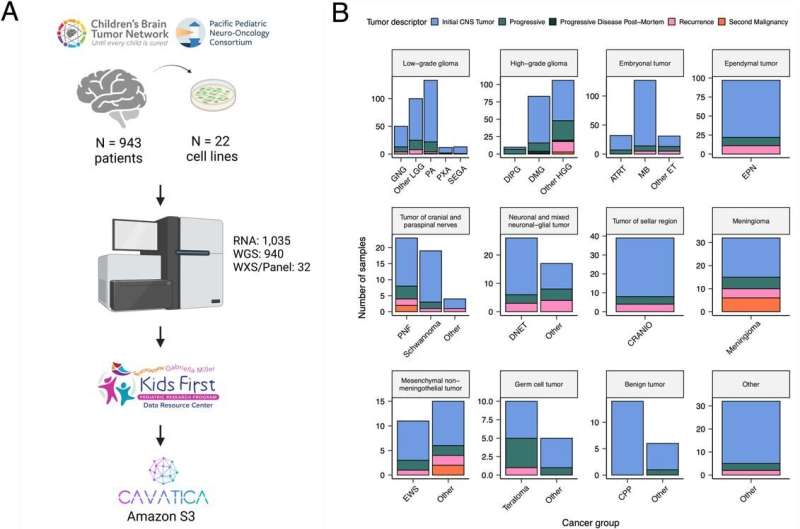This article has been reviewed according to Science X's editorial process and policies. Editors have highlighted the following attributes while ensuring the content's credibility:
fact-checked
peer-reviewed publication
trusted source
proofread
Open-analysis platform for pediatric brain tumors provides robust data resource for childhood cancer research

Researchers from Children's Hospital of Philadelphia (CHOP), the Alex's Lemonade Stand Foundation Childhood Cancer Data Lab, the Children's Brain Tumor Network (CBTN), the Pacific Pediatric Neuro-Oncology Consortium (PNOC), and more than 20 additional institutions have partnered to create a first-of-its-kind open-source, reproducible analysis platform for pediatric brain tumors.
With the help of thousands of genomically sequenced samples, researchers have used this platform to identify initial findings about genetic variants associated with poorer outcomes that could help guide future diagnostic and therapeutic advances.
The details of the platform and those initial findings were published online today by the journal Cell Genomics, after appearing on the bioRxiv preprint server.
Pediatric brain tumors are collectively the leading cause of cancer-related death in children in the United States. However, the severity of pediatric brain tumors varies wildly, with some having an almost universally fatal prognosis while others have relatively strong long-term survival rates, though all brain tumors negatively impact these children and their families to at least some degree.
Limited access to tissue samples and patient-derived cell lines has been a significant barrier to understanding the differences between pediatric brain tumors at a molecular level. That long sought-after data could lead to better diagnostic techniques and potential targeted therapies that could treat these deadly tumors.
In 2011, CBTN and PNOC began extracting and preparing what has now become nearly 6,000 tumor samples with over 68,000 sub-samples. More than 1,000 of these tumors were sequenced to form the initial release of the Pediatric Brain Tumor Atlas (PTBA) in 2018, and data were made available without embargo so that researchers could study what variants might be driving certain types of brain tumors.
With the help of the Alex's Lemonade Stand Foundation Childhood Cancer Data Lab, the team of researchers was able to build an open-source version of this atlas, the Open Pediatric Brain Tumor Atlas (OpenPBTA), to analyze these data.
OpenPBTA is accessible to anyone conducting research who is looking for new therapeutic targets or finding new ways to translate research into clinical practice. At the time of this study, OpenPBTA contained genomic and clinical data from more than 1,000 pediatric brain tumors and 22 patient-derived cell lines from the CBTN and PNOC.
The OpenPBTA provides an open, real-time framework to genomically characterize pediatric brain tumors. It is the first large-scale, collaborative, open analysis of genomic data and provides a cloud-based resource for researchers looking for more comprehensive data on pediatric brain tumors.
"While there have been many proponents of an open-source model for scientific research, nothing like this existed for pediatric cancer," said Jo Lynne Rokita, Ph.D., a Supervisory Bioinformatics Scientist leading OpenPBTA at the Center for Data-Driven Discovery (D3B) at CHOP and one of the study's corresponding authors. "We designed OpenPBTA so that anyone could access the data, contribute to its analysis, and/or use it in their own research."
"Collaboration is key to accelerating new cure discovery. OpenPBTA made it possible for experts across the globe to come together and gain a deeper understanding of the leading cause of cancer-related death in children and young adults," said Jay Scott, Co-Executive Director of Alex's Lemonade Stand Foundation.
Jaclyn N. Taroni, Ph.D., another corresponding author on the study and Director of Alex's Lemonade Stand Foundation Childhood Cancer Data Lab, said, "With our successful launch of OpenPBTA, we're hoping the research community adapts this model to other pediatric cancers."
OpenPBTA is already providing researchers with more insight into potential drivers of pediatric brain tumors. In this study, researchers found that the loss of the tumor suppressor gene TP53 is a significant marker for poor overall survival in fast-growing brain and spinal cord tumors called ependymomas and certain diffuse midline gliomas, and dysregulation of the gene was also implicated in hypermutant high-grade gliomas.
"Solving pediatric brain tumors cannot be accomplished by any one institution. The OpenPBTA model of shared, real-time collaboration supported by PNOC and CBTN has not only empowered new discoveries, but also innovative ways of performing the required science on behalf of accelerated, collaborative innovation for children affected by brain tumors," said Sabine Mueller MD, Ph.D., MAS, Professor of Neurology, Neurosurgery and Pediatrics at the University of California, San Francisco, and the Lead of PNOC and executive co-chair of CBTN.
More information: Joshua A. Shapiro et al, OpenPBTA: An Open Pediatric Brain Tumor Atlas, bioRxiv (2022). DOI: 10.1101/2022.09.13.507832
Joshua A. Shapiro et al, OpenPBTA: The Open Pediatric Brain Tumor Atlas, Cell Genomics (2023). DOI: 10.1016/j.xgen.2023.100340 , www.sciencedirect.com/science/ … 2666979X23001155?via%3Dihub



















